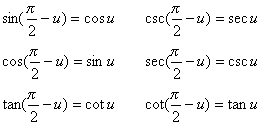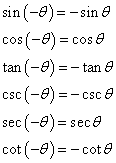Double-Angle Formulas : The most commonly used multiple-angle formulas. They are used often, so you should learn them.
sin2u = 2sinu cosu
cos 2u = cos^2u - sin^2u
=2cos^2u - 1
=1 - 2sin^2u
tan2u = (2tanu) / ( - tan^2u)
A visual proof for the Double-Angle Formula for Sine:

Power-Reducing Formulas: Can be obtained through the double-angle formulas
Sin^2X = (1-cos2X) / (2)
Cos^2X = (1 + cos2X) / (2)
Tan^2X = (1 - cos2X) / (1 + cos 2X)
Half-Angle Formulas : Can be derived from useful alternative forms of the power-reducing formulas be replacing "X" with (X/2)
Sin (X/2) = +/- * (1 - cosX) / (2)
Cos(X/2) = +/- * (1 + cosX) / (2)
Tan(X/2) = [ (1-cosX) / (sinX) ] = [ (sinX) / (1 + cosX) ]
* = square rooted

-Graphical Representation of a Half-Angle on the
Unit Circle
-I apologize for the lack of "actual" mathematical signs. I received trouble being able to enable the math widget on my computer. I did the best with the recourses at hand.






 This is the answer in degree form it can easily be changed into radians if you know your unit circle.
This is the answer in degree form it can easily be changed into radians if you know your unit circle.
 ( In reverse order, look at the part above)
( In reverse order, look at the part above)






